Discrete Element Simulation Modeling Method and Parameters Calibration of Sugarcane Leaves
Abstract
:1. Introduction
2. Materials and Methods
2.1. Test Materials
2.2. Angle of Repose Test
2.3. Simplification of Sugarcane Leaf Model
2.4. Simulation Model
2.4.1. Construction Method of the Non-Spherical Particle Model
2.4.2. Construction of Sugarcane Leaf Simulation Model
2.4.3. Construction of Cylinder-Lifting Simulation Model
2.4.4. Determination of Sugarcane Leaf Simulation Model
2.5. Response Surface Optimization Design of Simulation Model
2.5.1. Determination of the Simulation Parameter Range
2.5.2. Plackett-Burman Test
2.5.3. Steepest Ascent Search Test
2.5.4. Box-Behnken Test
2.6. Determination of Optimal Parameter Combination
3. Results and Discussion
3.1. Results of Physical Angle of Repose Test
3.2. Simplified Results of Sugarcane Leaf Model
3.3. Determination of Sugarcane Leaf Simulation Model
3.4. Response Surface Optimization of Optimal Parameters Combination
3.4.1. Results of Plackett-Burman Test
3.4.2. Results of Steepest Ascent Search Test
3.4.3. Results of Box-Behnken Test
3.4.4. Interaction Effects of the Regression Model
3.5. Optimal Parameter Combination and Test Verification
3.6. Gas-Solid Coupling Simulation Test
3.7. Discussion
- (1)
- The test results from Figure 10 show that the surface shape of sugarcane leaves had some influence on the angle of repose, and the relative error of angle of repose between flat leaves and actually mixed leaves was the smallest (2.35%). The field conditions of sugarcane leaves during harvesting are complex. Under the error condition that does not deviate from the actual situation, using sugarcane leaves with one shape to replace the complex mixed leaves for subsequent simulation modeling can simplify the complexity of the modeling process and improve the work efficiency. However, with the future upgrading of DEM simulation technology, the construction of complex models becomes relatively simple. The sugarcane leaf models can be built based on actual field conditions.
- (2)
- In the discrete element particle modeling, the smaller the particle radii, the more particle number, the higher the model accuracy, and the longer the simulation time. For micro-particles such as soil, fertilizer, and biomass particles materials, as well as flake particles such as leaves [12,41,42], it is generally necessary to enlarge the particles properly when constructing the DEM simulation model. The enlarged degree of the particle radii affects the material model’s accuracy and the simulation efficiency, which has always been a problem in constructing material DEM simulation models. The particle radii were generally selected based on experience without reasonable screening when modeling the above materials. This study analyzed the particle radii used in the discrete element modeling of thin sugarcane leaves. The study shows that the simulation efficiency decreases gradually, and the simulation angle of repose decreases gradually and tends to a constant value with the decrease of particle radii. Which reveals a balance between the simulation efficiency and the model accuracy; the simulation efficiency can be improved, and the model’s accuracy will not be reduced by using the spherical element with 2-mm radii to construct the sugarcane leaves simulation model. The research can provide some reference for the discrete element modeling of agricultural materials.
- (3)
- Relevant scholars [25,26] obtained the optimal parameters combination using the range analysis method based on the linear model but did not analyze the significance of each factor and interaction on the angle of repose. The range analysis method is simple and intuitive in data processing, but it has the disadvantages of low accuracy and poor predictability, thus there was a significant error in the optimal parameter combination obtained. Referring to the above research, the RSM based on the nonlinear model is adopted to analyze the effect of various significant and interactive factors on the angle of repose, the high-precision regression equation was obtained, and the optimal parameter combination was found by reasonable prediction.
4. Conclusions
- (1)
- The physical angle of repose of sugarcane leaves with different shapes was tested. The results showed that the greater the curling degree of sugarcane leaves, the greater the physical angle of repose. Via comparative analysis, the relative error of angle of repose between flat leaf and field actual mixed leaf was the smallest with 2.35%. Thus, the flat leaf was selected to replace the mixed leaf for subsequent sugarcane leaf simulation modeling and parameter calibration.
- (2)
- The multi-sphere polymerization method constructed five sugarcane leaf simulation models with different filling particle sizes. Via the cylinder-lifting simulation test, the effects of the five models on the simulation angle of repose and simulation efficiency were obtained, and the optimal filling particle size of the sugarcane leaf model was selected with r = 2 mm. Such a model was used for the following simulation parameter calibration.
- (3)
- The Plackett-Burman test was used to select the parameters that significantly influence the simulation angle of repose, and the second-order regression equation between the significant parameters and angle of repose was established based on the Box-Behnken test. Taking the physical angle of repose of 21.15° as the optimal target value, the optimal combination of parameters was as follows: the static and rolling friction coefficients between sugarcane leaves were 0.21 and 0.05 respectively, and the static friction coefficient between sugarcane leaves and steel was 0.30.
- (4)
- An independent sample t-test verified the optimal parameter combination. The result showed no significant difference between the simulation angle of repose and the physical angle of repose, and the relative error between them was 3.71%, which further verified the reliability of sugarcane leaf discrete element calibration parameters.
- (5)
- The gas-solid coupling simulation test was conducted with the trash content as the test index and compared with the field test. The test results showed that the maximum relative error between simulation value and test value was 8%. It further showed that the modeling mothed and parameter calibration of the sugarcane leaf model were accurate and reliable and could be used for subsequent gas-solid coupling simulation research.
Author Contributions
Funding
Institutional Review Board Statement
Informed Consent Statement
Data Availability Statement
Conflicts of Interest
References
- Xing, H.M.; Ma, S.C.; Wang, F.L.; Bai, J.; Ma, J.Z. Aerodynamic performance evaluation of sugarcane harvester extractor based on CFD. Sugar Tech. 2021, 23, 627–633. [Google Scholar] [CrossRef]
- Xie, F.X.; Ou, Y.G.; Liu, Q.T.; Zou, X.P.; Feng, J.M. Design and experiment of impurity discharging fan of sugarcane harvester. Trans. Chin. Soc. Agric. Eng. 2012, 28, 8–14. [Google Scholar] [CrossRef]
- Xie, F.X.; Ou, Y.G.; Liu, Q.T.; Wang, C.Z. Virtual experiment on material flow simulation for whole stalk sugarcane harvester. In Proceedings of the 2011 International Conference on New Technology of Agricultural Engineering, Zibo, China, 27–29 May 2011; pp. 185–188. [Google Scholar] [CrossRef]
- Xing, H.M.; Ma, S.C.; Wang, F.L.; Bai, J.; Hu, J.W. Structure optimization and experiment of sugarcane chopper harvester extractor. Trans. Chin. Soc. Agric. Eng. 2020, 36, 67–75. [Google Scholar] [CrossRef]
- Horabik, J.; Molenda, M. Parameters and contact models for DEM simulations of agricultural granular materials: A review. Biosyst. Eng. 2016, 147, 206–225. [Google Scholar] [CrossRef]
- Oinonen, A.; Marquis, G. A constitutive model for interface problems with frictional contact and cohesion. Eur. J. Mech. A Solids 2015, 49, 205–213. [Google Scholar] [CrossRef]
- Zeng, Z.W.; Ma, X.; Cao, X.L.; Li, Z.H.; Wang, X.C. Critical review of applications of discrete element method in agricultural engineering. Trans. Chin. Soc. Agric. Mach. 2021, 52, 1–20. [Google Scholar] [CrossRef]
- Zhang, R.F.; Jiao, W.; Zhou, J.L.; Qi, B.; Liu, H.; Xia, Q.Q. Parameter Calibration and Experiment of Seed Discrete Element Model with Different Filling Particle Radius. Trans. Chin. Soc. Agric. Mach. 2020, 51, 227–235. [Google Scholar] [CrossRef]
- Wang, Y.X.; Liang, Z.J.; Zhang, D.X.; Cui, T.; Shi, S.; Li, K.H.; Yang, L. Calibration method of contact characteristic parameters for corn seeds based on EDEM. Trans. Chin. Soc. Agric. Eng. 2016, 32, 36–42. [Google Scholar] [CrossRef]
- Zhang, R.; Han, D.L.; Ji, Q.L.; He, Y.; Li, J.Q. Calibration methods of sandy soil parameters in simulation of discrete element method. Trans. Chin. Soc. Agric. Mach. 2017, 48, 49–56. [Google Scholar] [CrossRef]
- Wu, T.; Huang, W.F.; Chen, X.S.; Ma, X.; Han, Z.Q.; Pan, T. Calibration of discrete element parameters for cohesive soil considering the cohesion between particle. J. South China Agric. Univ. 2017, 38, 93–98. [Google Scholar] [CrossRef]
- Wang, L.M.; Fan, S.Y.; Cheng, H.S.; Meng, H.B.; Shen, Y.J.; Wang, J.; Zhou, H.B. Calibration of contact parameters for pig manure based on EDEM. Trans. Chin. Soc. Agric. Eng. 2020, 36, 95–102. [Google Scholar] [CrossRef]
- Wan, X.Y.; Liao, Q.X.; Jiang, Y.J.; Shan, Y.Y.; Zhou, Y.; Liao, Y.T. Discrete element simulation and experiment of stem chopping for fodder rape crop harvest. J. Jilin Univ. Eng. Technol. Ed. 2021, 1–9. [Google Scholar] [CrossRef]
- Ghodki, B.M.; Patel, M.; Namdeo, R.; Carpenter, G. Calibration of discrete element model parameters: Soybeans. Comput. Part. Mech. 2018, 6, 3–10. [Google Scholar] [CrossRef]
- Liu, F.Y.; Chen, J. Effect of calibration experiments on the micro-parameters of wheat required in discrete element simulations. In Proceedings of the American Society of Agricultural and Biological Engineers (ASABE), 2017 Spokane, Washington, DC, USA, 16–19 July 2017. Paper Number: 1701337. [Google Scholar] [CrossRef]
- Zhang, T.; Liu, F.; Zhao, M.Q.; Liu, Y.Q.; Li, F.L.; Ma, Q.; Zhang, Y.; Zhou, P. Measurement of physical parameters of contact between soybean seed and seed metering device and discrete device element simulation calibration. J. China Agric. Univ. 2017, 22, 86–92. [Google Scholar] [CrossRef]
- Wu, M.C.; Cong, J.L.; Yan, Q.; Zhu, T.; Peng, X.Y.; Wang, Y.S. Calibration and experiments for discrete element simulation parameters of peanut seed particles. Trans. Chin. Soc. Agric. Eng. 2020, 36, 30–38. [Google Scholar] [CrossRef]
- Hou, Z.F.; Dai, N.Z.; Chen, Z.; Qiu, Y.; Zhang, X.W. Measurement and Calibration of physical property parameters for Agropyron seeds in a discrete element Simulation. Trans. Chin. Soc. Agric. Eng. 2020, 36, 46–54. [Google Scholar] [CrossRef]
- Yu, Q.X.; Liu, Y.; Chen, X.B.; Sun, K.; Lai, Q.H. Calibration and experiment of simulation parameters for panax notoginseng seeds based on DEM. Trans. Chin. Soc. Agric. Mach. 2020, 51, 123–132. [Google Scholar] [CrossRef]
- Ma, S.; Xu, L.; Yuan, Q.C.; Niu, C.; Zeng, J.; Chen, C.; Wang, S.S.; Yuan, X.T. Calibration of discrete element simulation parameters of grapevine antifreezing soil and its interaction with soil-cleaning components. J. South China Agric. Univ. 2020, 36, 40–49. [Google Scholar] [CrossRef]
- Scheffler, O.C.; Coetzee, C.J.; Opara, U.L. A discrete element model (DEM) for predicting apple damage during handling. Biosyst. Eng. 2018, 172, 29–48. [Google Scholar] [CrossRef]
- Kafashan, J.; Wiacek, J.; Ramon, H.; Mouazen, A.M. Modelling and simulation of fruit drop tests by discrete element method. Biosyst. Eng. 2021, 212, 228–240. [Google Scholar] [CrossRef]
- Wang, Y.; Zhang, Y.T.; Yang, Y.; Zhao, H.M.; Yang, C.H.; He, Y.; Wang, K.; Liu, D.; Xu, H.B. Discrete element modelling of citrus fruit stalks and its verification. Biosyst. Eng. 2020, 200, 400–414. [Google Scholar] [CrossRef]
- Zhao, L.; Zhou, H.; Xu, L.; Song, S.Y.; Zhang, C.; Yu, Q.G. Parameter calibration of coconut bran substrate simulation model based on discrete element and response surface methodology. Powder Technol. 2021, 395, 183–194. [Google Scholar] [CrossRef]
- Wen, X.; Yang, W.; Guo, W.J.; Zheng, B. Parameters determination and verification of discrete element of segmented sugarcane harvester for impurity removal. J. Chin. Agric. Mech. 2020, 41, 12–18. [Google Scholar] [CrossRef]
- Guo, W.J.; Yang, W.; Wen, X.; Yang, J.; Mo, J.L.; Ceng, B.S.; Nong, H.L. Research on simulation modeling method of sugarcane harvester’s removing impurities operation. J. Agric. Mech. Res. 2020, 42, 6–12. [Google Scholar] [CrossRef]
- Jia, H.L.; Deng, J.Y.; Deng, Y.L.; Chen, T.Y.; Wang, G.; Sun, Z.J.; Guo, H. Contact parameter analysis and calibration in discrete element simulation of rice straw. Int. J. Agric. Biol. Eng. 2021, 14, 72–81. [Google Scholar] [CrossRef]
- Liao, Y.T.; Wang, Z.T.; Liao, Q.X.; Wan, X.Y.; Zhou, Y.; Liang, F. Calibration of discrete element model parameters of forage rape stalk at early pod stage. Trans. Chin. Soc. Agric. Mach. 2020, 51, 236–243. [Google Scholar] [CrossRef]
- Derakhshani, S.M.; Schott, D.L.; Lodewijks, G. Micro–macro properties of quartz sand: Experimental investigation and DEM simulation. Powder Technol. 2015, 269, 127–138. [Google Scholar] [CrossRef]
- Jia, F.G.; Han, Y.L.; Liu, Y.; Cao, Y.P.; Shi, Y.F.; Yao, L.N.; Wang, H. Simulation prediction method of angle of repose for rice particle materials. J. Agric. Mech. Res. 2014, 30, 254–260. [Google Scholar] [CrossRef]
- Han, Y.L.; Jia, F.G.; Tang, Y.R.; Liu, Y.; Zhang, Q. Influence of granular coefficient of rolling friction on accumulation characteristics. Acta Phys. Sin. 2014, 63, 174501. [Google Scholar] [CrossRef]
- Favier, J.F.; Abbaspour-Fard, M.H.; Kremmer, M.; Raji, A.O. Shape representation of axi-symmetrical, non-spherical particles in discrete element simulation using multi-element model particles. Eng. Comput. 1999, 16, 467–480. [Google Scholar] [CrossRef]
- Abbaspour-Fard, M.H. Theoretical Validation of a Multi-sphere, Discrete Element Model Suitable for Biomaterials Handling Simulation. Biosyst. Eng. 2004, 88, 153–161. [Google Scholar] [CrossRef]
- Kruggel-Emden, H.; Rickelt, S.; Wirtz, S.; Scherer, V. A study on the validity of the multi-sphere discrete element method. Powder Technol. 2008, 188, 153–165. [Google Scholar] [CrossRef]
- Salot, C.; Gotteland, P.; Villard, P. Influence of relative density on granular materials behavior: DEM simulations of triaxial tests. Granul. Matter 2009, 11, 221–236. [Google Scholar] [CrossRef]
- Kozhar, S.; Dosta, M.; Antonyuk, S.; Heinrich, S.; Bröckel, U. DEM simulations of amorphous irregular shaped micrometer-sized titania agglomerates at compression. Adv. Powder Technol. 2015, 26, 767–777. [Google Scholar] [CrossRef]
- Yuan, J.B.; Li, H.; Wu, C.Y.; Qi, X.D.; Shi, X.X.; Li, C. Study on apace particle modeling of rice grain basis on the discrete element method. J. Nanjing Agric. Univ. 2018, 41, 1151–1158. [Google Scholar] [CrossRef]
- Wang, M.M.; Wang, W.Z.; Yang, L.G.; Hou, M.T. Research of discrete element modeling method of maizekernel based on EDEM. J. Henan Agric. Univ. 2018, 52, 80–84. [Google Scholar] [CrossRef]
- Liu, J.; Yu, G.; Zhao, C.J.; Hu, W.; Qiu, H.L. 2D DEM simulation on the sand pile formation for granular materials with different grain size distributions. Chin. J. Comput. Mech. 2008, 25, 568–573. [Google Scholar]
- Coetzee, C.J. Particle up scaling: Calibration and validation of the discrete element method. Powder Technol. 2018, 344, 487–503. [Google Scholar] [CrossRef]
- Aikins, K.A.; Ucgul, M.; Barr, J.B.; Jensen, T.A.; Antille, D.L.; Desbiolles, J.M. Determination of discrete element model parameters for a cohesive soil and validation through narrow point opener performance analysis. Soil Tillage Res. 2021, 213, 105123. [Google Scholar] [CrossRef]
- Wang, W.W.; Cai, D.Y.; Xie, J.J.; Zhang, C.; Liu, L.; Chen, L. Parameters calibration of discrete element model for corn stalk powder compression simulation. Trans. Chin. Soc. Agric. Mach. 2021, 52, 127–134. [Google Scholar] [CrossRef]
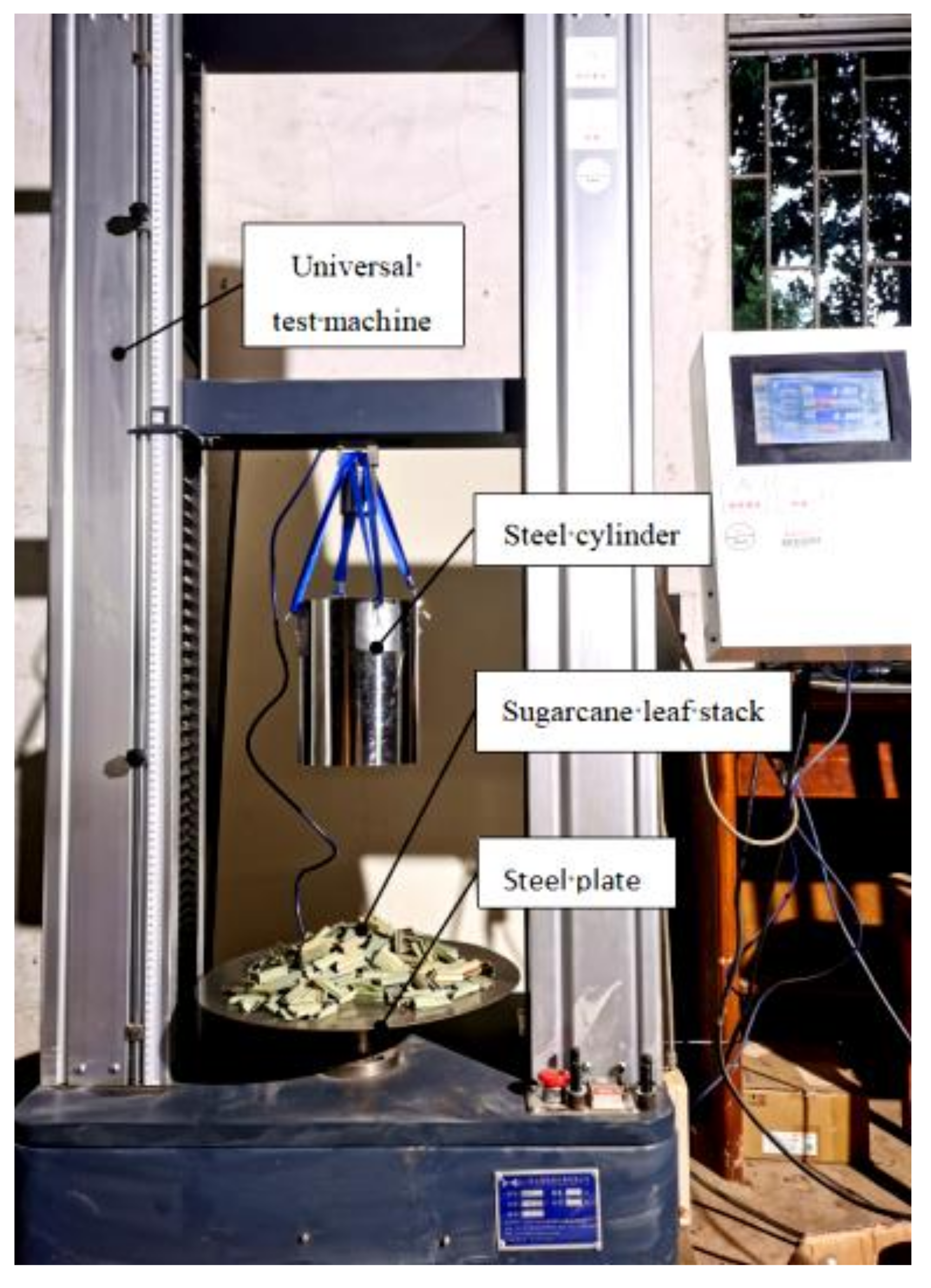
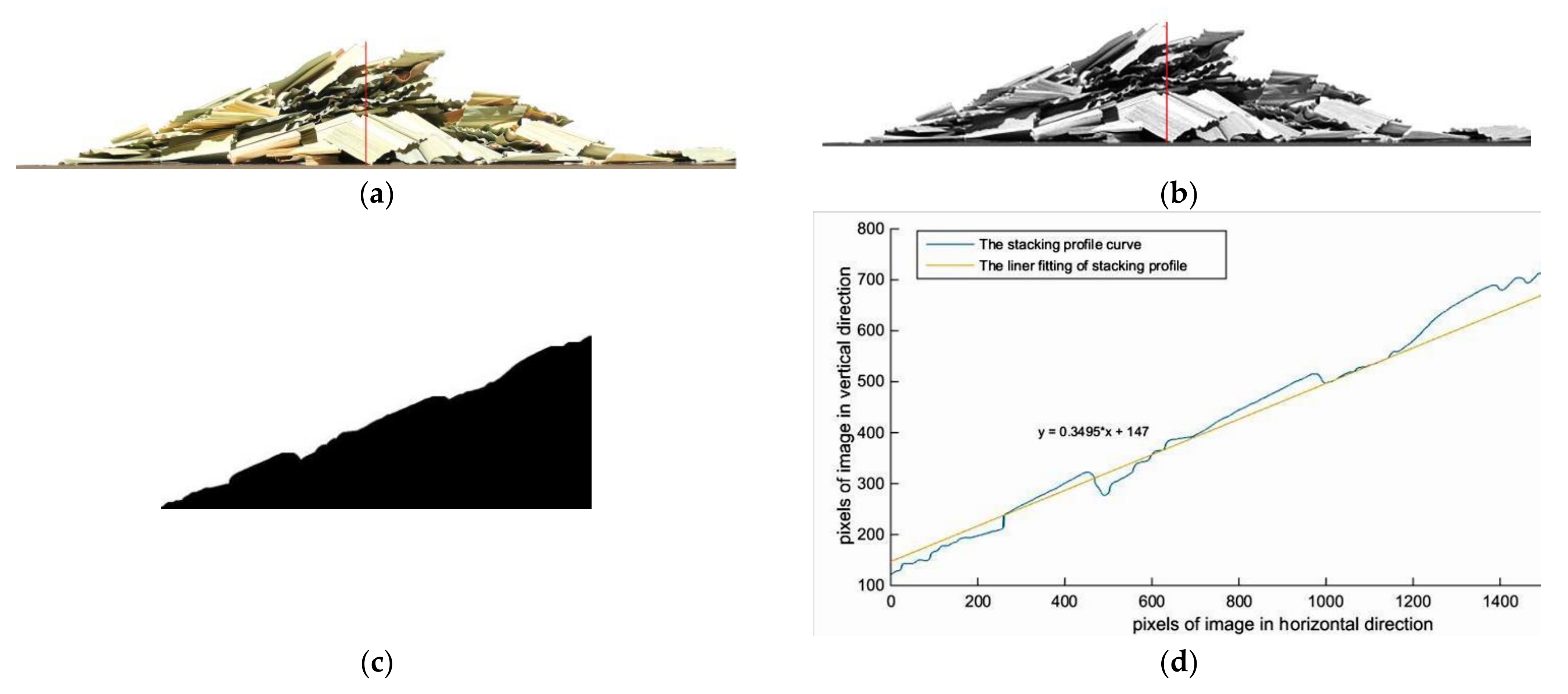

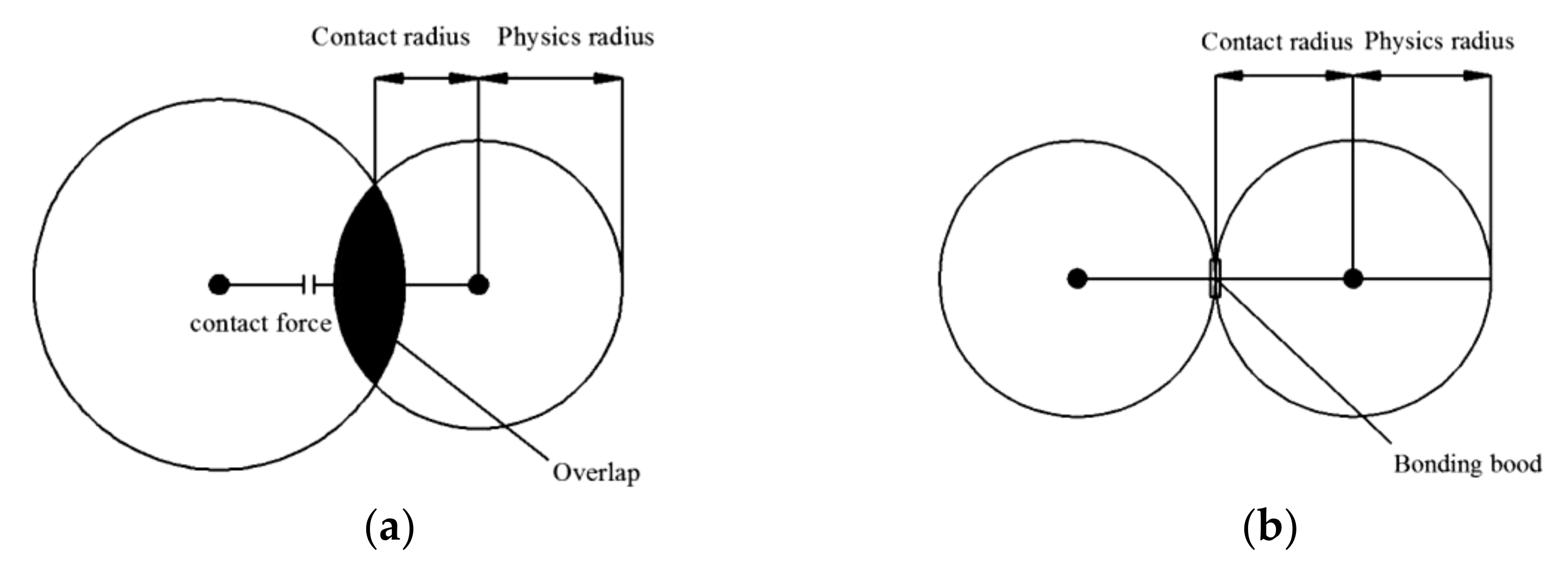




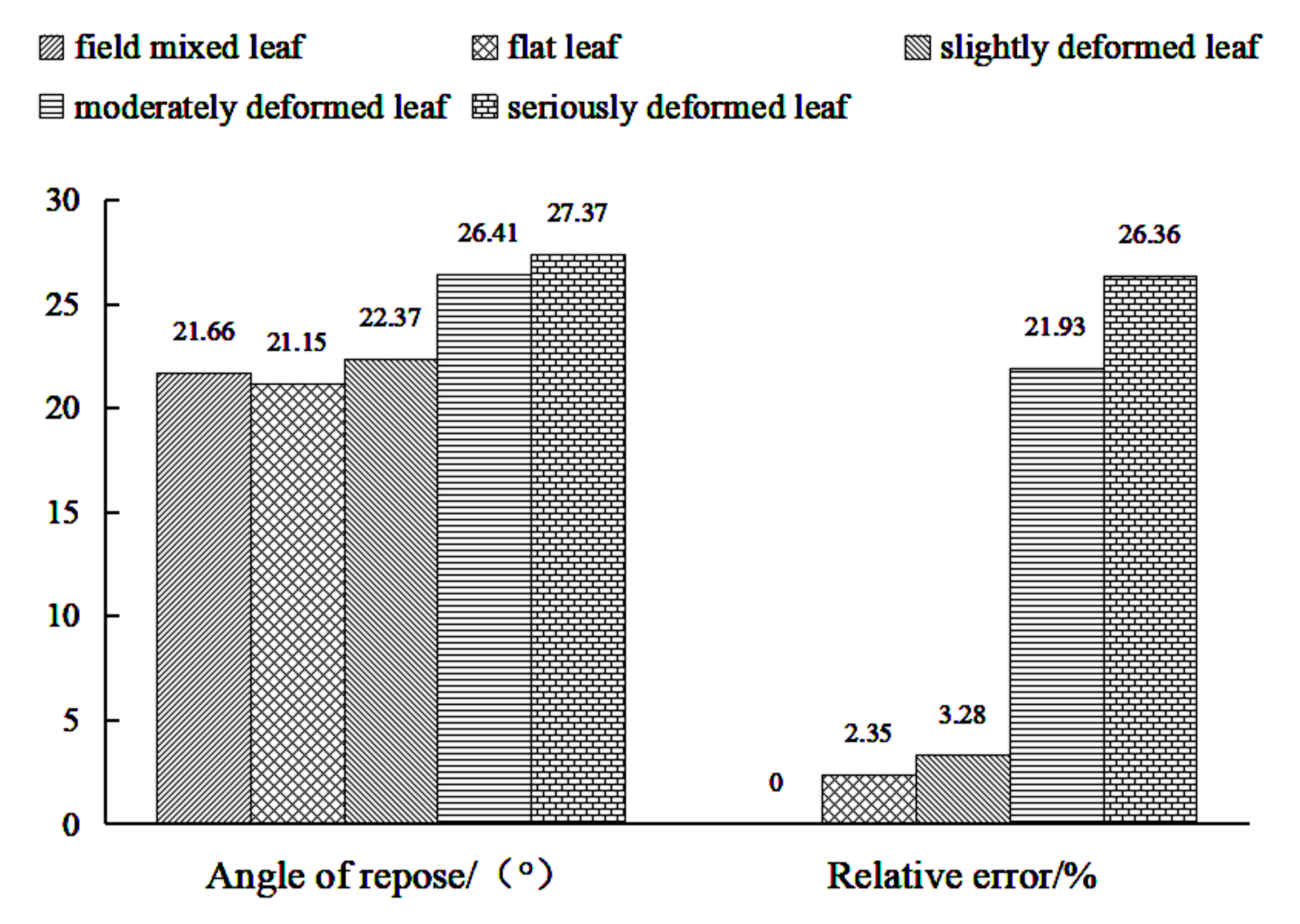

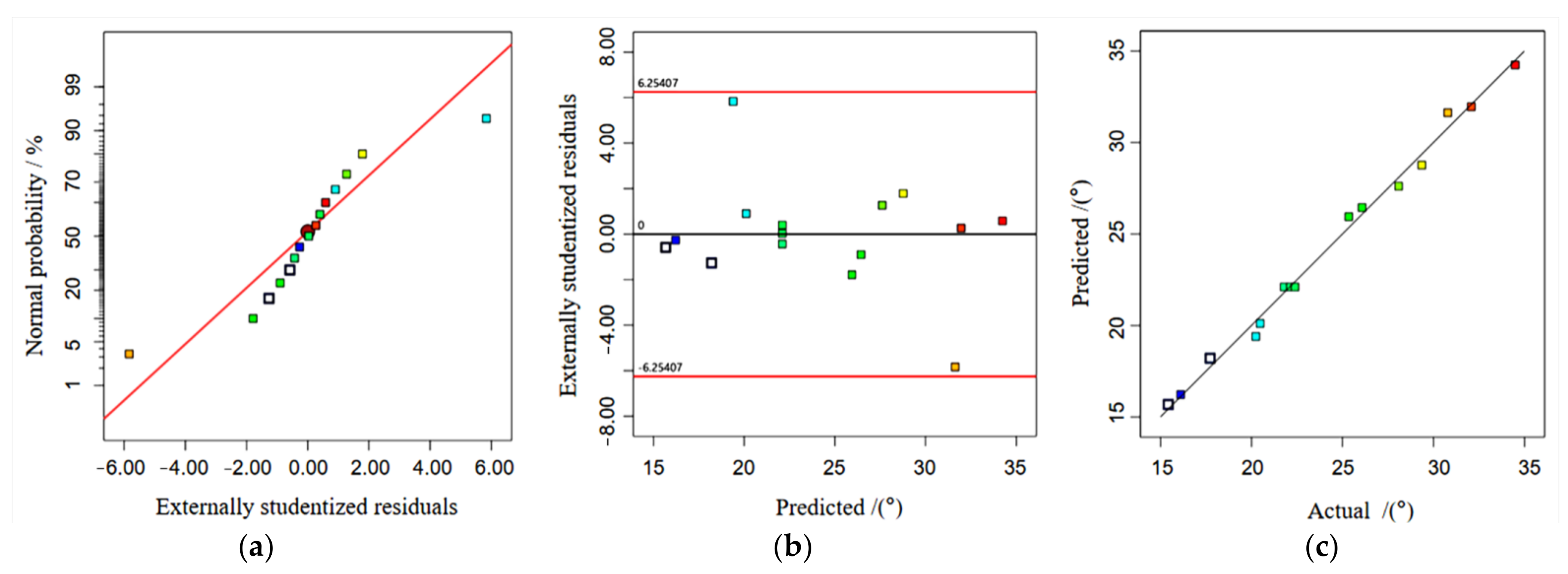

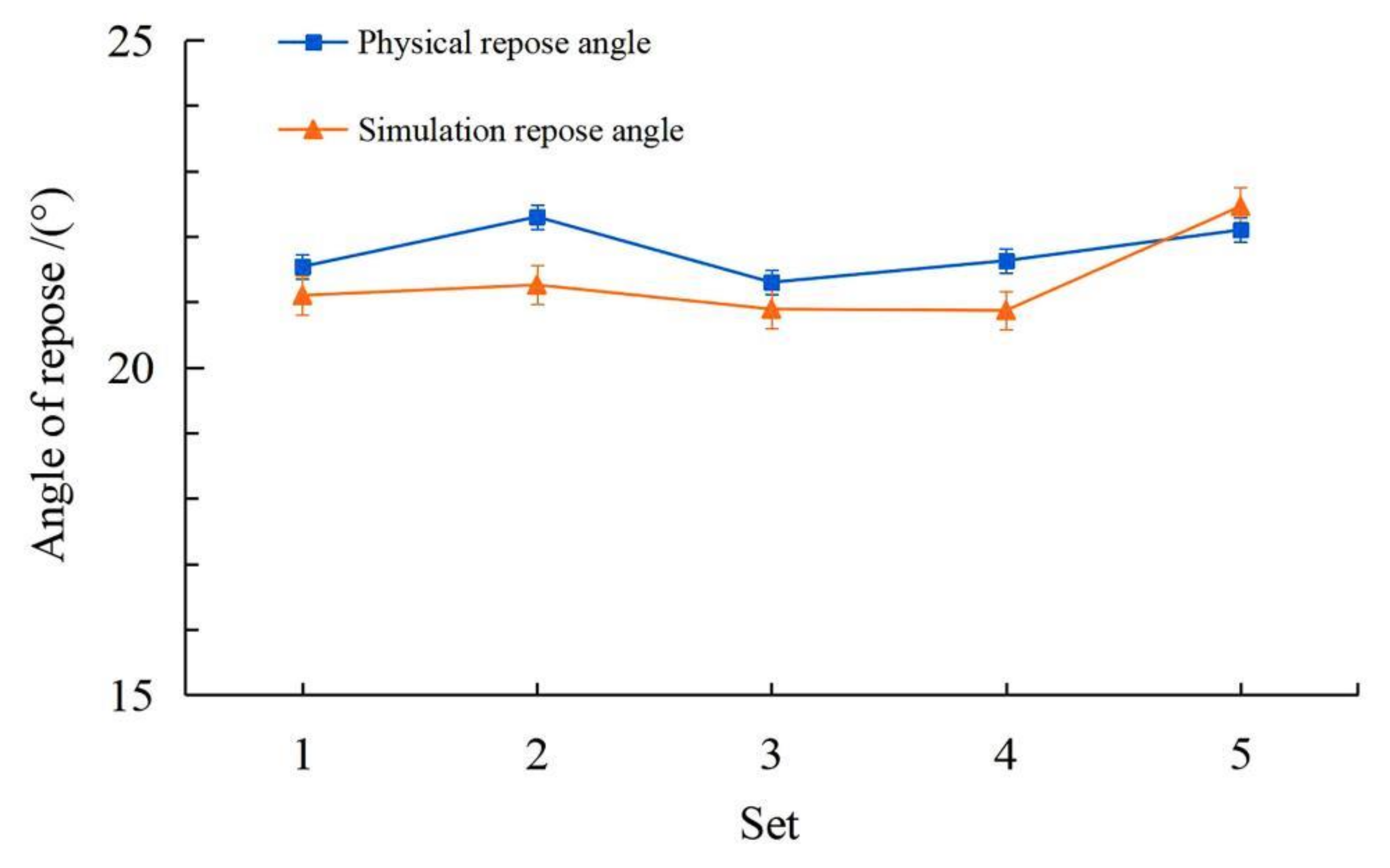


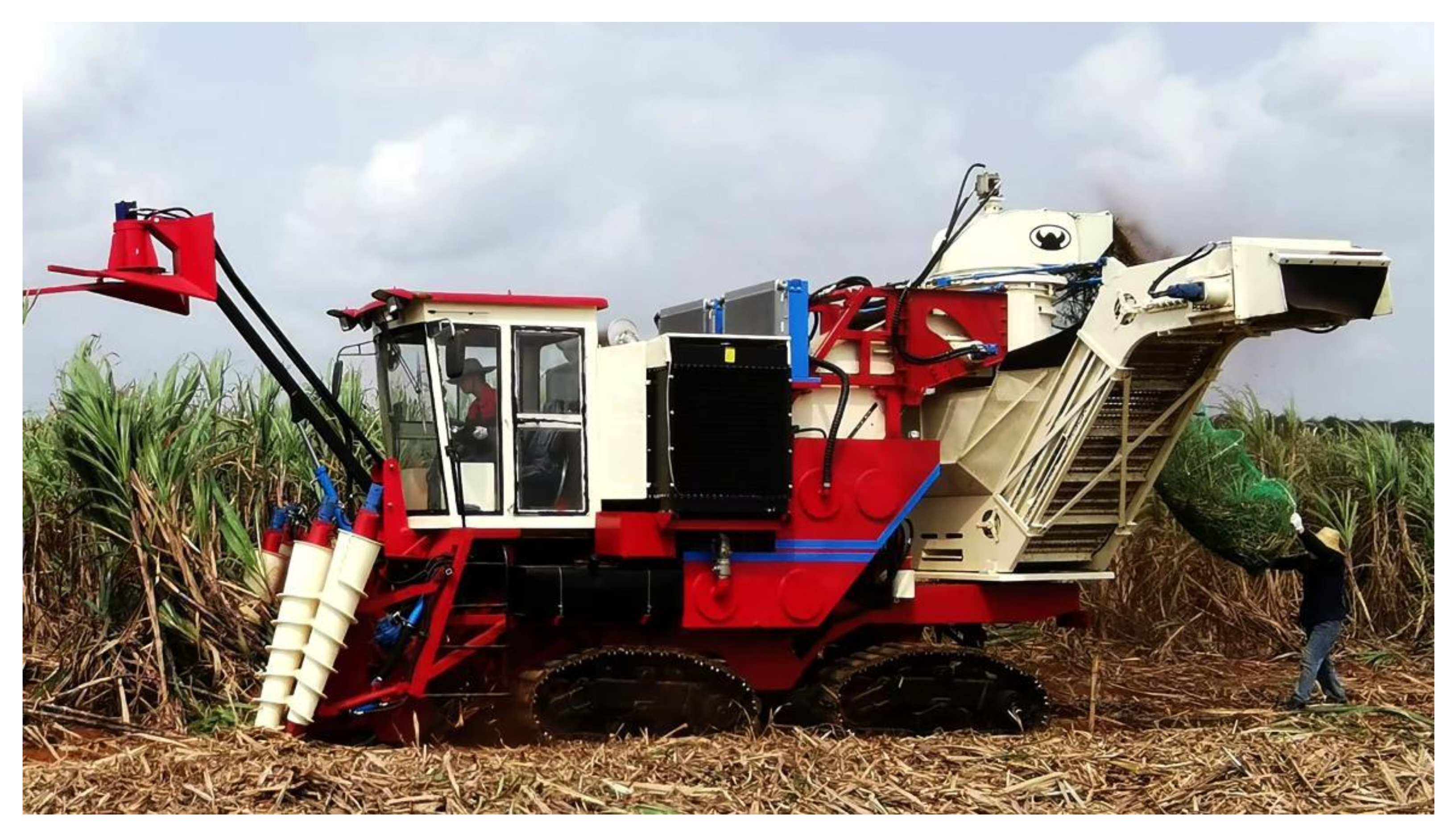
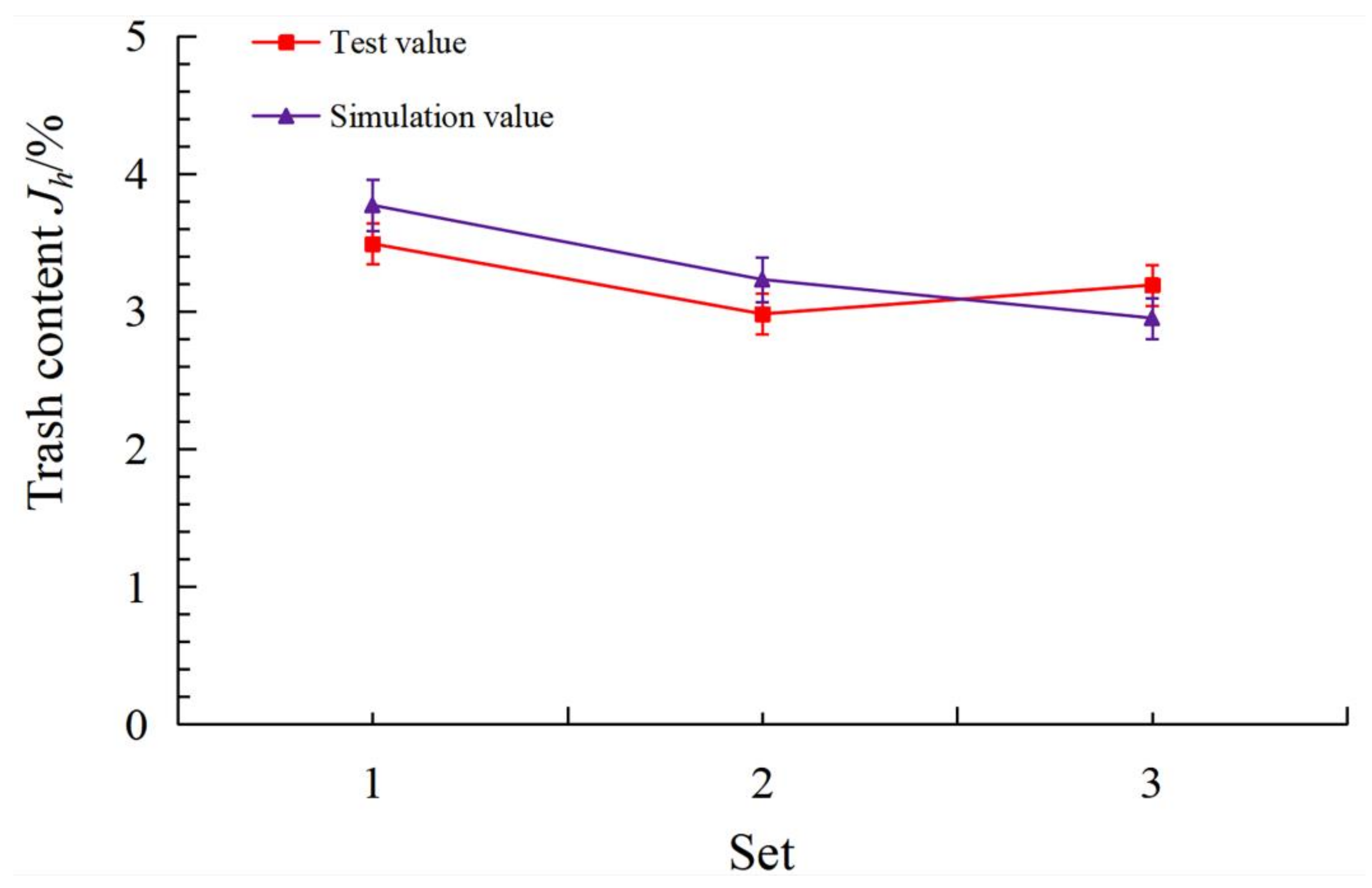
| Material | Property | Value | Source |
|---|---|---|---|
| Sugarcane leaf | Poisson’s ratio | 0.2~0.4 | Literature [25,26] |
| Shear Modulus, Mpa | 100~500 | ||
| Density, g cm−3 | 0.38 | ||
| Steel | Poisson’s ratio | 0.30 | |
| Shear modulus, Mpa | 7.9 × 104 | ||
| Density, g. cm−3 | 7.85 | ||
| Sugarcane leaf-Sugarcane leaf | Restitution coefficient | 0.001~0.003 | |
| Static friction coefficient | 0.10~0.60 | ||
| Rolling friction coefficient | 0.02~0.06 | ||
| Sugarcane leaf-Steel | Restitution coefficient | 0.001~0.005 | |
| Static friction coefficient | 0.10~0.60 | ||
| Rolling friction coefficient | 0.01~0.05 |
| Symbol | Parameters | Low Level (−1) | High level (+1) |
|---|---|---|---|
| X1 | Poisson’s ratio for the sugarcane leaf | 0.20 | 0.40 |
| X2 | Shear modulus of the sugarcane leaf | 100 | 500 |
| X3 | Sugarcane leaf-sugarcane leaf restitution coefficient | 0.001 | 0.003 |
| X4 | Sugarcane leaf-sugarcane leaf static friction coefficient | 0.10 | 0.50 |
| X5 | Sugarcane leaf-sugarcane leaf rolling friction coefficient | 0.02 | 0.06 |
| X6 | Sugarcane leaf-steel restitution coefficient | 0.001 | 0.005 |
| X7 | Sugarcane leaf-steel static friction coefficient | 0.20 | 0.60 |
| X8 | Sugarcane leaf-steel rolling friction coefficient | 0.01 | 0.05 |
| Sets | Angle of Repose Range | Mean Value | Standard Deviation |
|---|---|---|---|
| A | 19.23~24.12° | 21.66° | 2.13 |
| B | 18.61~23.51° | 21.15° | 1.79 |
| C | 21.00~23.28° | 22.37° | 0.97 |
| D | 24.85~28.95° | 26.41° | 1.81 |
| E | 26.10~29.83° | 27.37° | 0.71 |
| Sets | Particle Radii, mm | Number of particles | X View Angle of Repose, (°) | Y View Angle of Repose, (°) | Average Angle of Repose, (°) | Simulation Time, h |
|---|---|---|---|---|---|---|
| A | 0.5 | 1296 | 28.16 | 24.44 | 26.30 | ** |
| B | 1.0 | 324 | 29.28 | 24.02 | 26.65 | * |
| C | 2.0 | 64 | 27.91 | 26.47 | 27.19 | 4.0 |
| D | 3.0 | 36 | 35.26 | 29.37 | 32.31 | 1.5 |
| E | 4.0 | 25 | 36.04 | 32.06 | 34.05 | 0.5 |
| No. | Test Parameters | Angle of Repose, θ/(°) | |||||||
|---|---|---|---|---|---|---|---|---|---|
| X1 | X2 | X3 | X4 | X5 | X6 | X7 | X8 | ||
| 1 | 1 (0.4) | 1 | −1 | 1 | 1 | 1 | −1 | −1 | 33.38 |
| 2 | −1 (0.2) | 1 (500) | 1 | −1 | 1 | 1 | 1 | −1 | 15.15 |
| 3 | 1 | −1 (100) | 1 (0.003) | 1 | −1 | 1 | 1 | 1 | 32.37 |
| 4 | −1 | 1 | −1 (0.001) | 1 (0.5) | 1 | −1 | 1 | 1 | 41.57 |
| 5 | −1 | −1 | 1 | −1 (0.1) | 1 (0.06) | 1 | −1 | 1 | 14.45 |
| 6 | −1 | −1 | −1 | 1 | −1 (0.02) | 1 (0.005) | 1 | −1 | 36.42 |
| 7 | 1 | −1 | −1 | −1 | 1 | −1 (0.001) | 1 (0.6) | 1 | 17.47 |
| 8 | 1 | 1 | −1 | −1 | −1 | 1 | −1 (0.2) | 1 (0.05) | 10.32 |
| 9 | 1 | 1 | 1 | −1 | −1 | −1 | 1 | −1 (0.01) | 11.97 |
| 10 | −1 | 1 | 1 | 1 | −1 | −1 | −1 | 1 | 29.52 |
| 11 | 1 | −1 | 1 | 1 | 1 | −1 | −1 | −1 | 34.86 |
| 12 | −1 | −1 | −1 | −1 | −1 | −1 | −1 | −1 | 12.86 |
| 13 | 0 | 0 | 0 | 0 | 0 | 0 | 0 | 0 | 28.01 |
| Parameters | Sum of Square | Degree of Freedom | F Value | p Value | Significance Ranking |
|---|---|---|---|---|---|
| X1 | 7.680 | 1 | 2.719 | 0.198 | 5 |
| X2 | 3.543 | 1 | 1.254 | 0.344 | 6 |
| X3 | 15.641 | 1 | 5.537 | 0.100 | 4 |
| X4 | 1320.901 | 1 | 467.614 | 0.000 ** | 1 |
| X5 | 45.708 | 1 | 16.181 | 0.028 * | 2 |
| X6 | 3.162 | 1 | 1.119 | 0.368 | 7 |
| X7 | 31.883 | 1 | 11.287 | 0.044 * | 3 |
| X8 | 0.094 | 1 | 0.033 | 0.867 | 8 |
| NO. | X4 | X5 | X7 | Angle of Repose, θ/(°) | Relative Error, % |
|---|---|---|---|---|---|
| 1 | 0.10 | 0.02 | 0.20 | 10.54 | 50.04 |
| 2 | 0.20 | 0.03 | 0.30 | 18.28 | 13.36 |
| 3 | 0.30 | 0.04 | 0.40 | 22.74 | 7.77 |
| 4 | 0.40 | 0.05 | 0.50 | 30.75 | 45.73 |
| 5 | 0.50 | 0.06 | 0.60 | 41.91 | 98.63 |
| No. | Test Factors | Angle of Repose, θ/(°) | ||
|---|---|---|---|---|
| X4 | X5 | X7 | ||
| 1 | −1 (0.2) | 0 | −1 (0.3) | 16.11 |
| 2 | −1 | 0 | 1 (0.5) | 20.24 |
| 3 | 1 (0.4) | 0 | −1 | 30.79 |
| 4 | 1 | 0 | 1 | 32.08 |
| 5 | −1 | −1 (0.03) | 0 (0.4) | 15.43 |
| 6 | 1 | −1 | 0 | 28.09 |
| 7 | −1 | 1 (0.05) | 0 | 17.73 |
| 8 | 1 | 1 | 0 | 34.49 |
| 9 | 0 (0.3) | −1 | −1 | 20.48 |
| 10 | 0 | −1 | 1 | 25.35 |
| 11 | 0 | 1 | −1 | 29.36 |
| 12 | 0 | 1 | 1 | 26.08 |
| 13 | 0 | 0 (0.04) | 0 | 22.13 |
| 14 | 0 | 0 | 0 | 22.39 |
| 15 | 0 | 0 | 0 | 21.80 |
| Source of Variance | Sum of Squares | Degrees of Freedom | Mean Square | p Value |
|---|---|---|---|---|
| Model | 481.91 | 9 | 53.55 | 0.0001 ** |
| X4 | 391.16 | 1 | 391.16 | 0.0001 ** |
| X5 | 41.91 | 1 | 41.91 | 0.0005 ** |
| X7 | 6.14 | 1 | 6.14 | 0.0264 * |
| X4X5 | 4.20 | 1 | 4.20 | 0.0496 * |
| X4X7 | 2.02 | 1 | 2.02 | 0.1343 |
| X5X7 | 16.61 | 1 | 16.61 | 0.0037 ** |
| X42 | 1.60 | 1 | 1.60 | 0.1728 |
| X52 | 5.06 | 1 | 5.06 | 0.0368 * |
| X72 | 15.37 | 1 | 15.37 | 0.0044 ** |
| Residual | 3.16 | 5 | 0.6326 | / |
| Lack of Fit | 2.99 | 3 | 0.9961 | 0.0818 |
| Pure Error | 0.1749 | 2 | 0.0874 | / |
| Sum | 485.07 | 14 | / | / |
| R2 = 0.9935 | R2adj = 0.9817 | CV = 3.29% | Adequate precision = 28.5825 | |
Publisher’s Note: MDPI stays neutral with regard to jurisdictional claims in published maps and institutional affiliations. |
© 2022 by the authors. Licensee MDPI, Basel, Switzerland. This article is an open access article distributed under the terms and conditions of the Creative Commons Attribution (CC BY) license (https://creativecommons.org/licenses/by/4.0/).
Share and Cite
Ren, J.; Wu, T.; Mo, W.; Li, K.; Hu, P.; Xu, F.; Liu, Q. Discrete Element Simulation Modeling Method and Parameters Calibration of Sugarcane Leaves. Agronomy 2022, 12, 1796. https://doi.org/10.3390/agronomy12081796
Ren J, Wu T, Mo W, Li K, Hu P, Xu F, Liu Q. Discrete Element Simulation Modeling Method and Parameters Calibration of Sugarcane Leaves. Agronomy. 2022; 12(8):1796. https://doi.org/10.3390/agronomy12081796
Chicago/Turabian StyleRen, Jiahui, Tao Wu, Wangyujie Mo, Ke Li, Ping Hu, Fengying Xu, and Qingting Liu. 2022. "Discrete Element Simulation Modeling Method and Parameters Calibration of Sugarcane Leaves" Agronomy 12, no. 8: 1796. https://doi.org/10.3390/agronomy12081796






